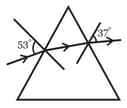Refraction of Light Through Prism
Refraction of Light Through Prism: Overview
This Topic covers sub-topics such as Prism, Chromatic Aberration, Angle of Prism, Dispersive Power, Dispersion of Light in Prism, Formation of Secondary Rainbow, Condition for Minimum Deviation in Prism and, Formation of Primary Rainbow
Important Questions on Refraction of Light Through Prism
It is desired to make an achromatic combination of two lenses and . If the combination of lenses is converging then
A thin prism of angle is placed at a distance of from the object. The distance of the image from the object is (given of prism)
A prism has a refractive index and refracting angle . Find the minimum deviation produced by prism
A ray incident at angle 53o on a prism emerges at an angle at 37o as shown. If the angle of incidence is made 50o, which of the following is a possible value of the angle of emergence.

A parallel beam of light falls normaly on the first face of a prism of small angle. At the second face it is partly transmitted and partly reflected, the reflected beam striking at the first face again, and emerging from it in a direction making an angle 6o 30' with the reversed direction of the incident beam. The refracted beam is found to have undergone a deviation of 1o 15' from the original direction. Find the refractive index of the glass and the angle of the prism.
The refractive indices of the crown glass for violet and red lights are and respectively and those of the flint glass are and respectively. A prism of angle is made of crown glass. A beam of white light is incident at a small angle on this prism. The other thin flint glass prism is combined with the crown glass prism such that net mean deviation is anticlockwise.
A screen is placed normal to the emerging beam at a distance of from the prism combination. Find the distance between red and violet spot on the screen. Which is the topmost colour on screen.
How does the angle of minimum deviation of a glass prism vary, if the incident violet light is replaced with red light?
A ray of light undergoes deviation of when incident on an equilateral prism of refractive index What is the angle subtended by the ray inside the prism with the base of the prism is ?
Which one of the following spherical lenses does not exhibit dispersion? The radii of curvature of the surfaces of the lenses are as given in the diagrams.
Which one of the following spherical lenses does not exhibit dispersion? The radii of curvature of the surfaces of the lenses are as given in the diagrams.
A given ray of light suffers minimum deviation in an equilateral prism . Additional prism and of identical shape and of the same material as are now added as shown in the figure. The ray will now suffer

A given ray of light suffers minimum deviation in an equilateral prism . Additional prism and of identical shape and of the same material as are now added as shown in the figure. The ray will now suffer

Spherical aberration in a thin lens can be reduced by
Refractive index of a transparent material is
The formation of primary rainbow is due to
Dispersive power is dependent on
During dispersion of white light by the glass prism, which of the following light of the spectrum bends the most
The maximum refractive index of a prism which permits the passage of light through it, when the refracting angle of the prism is is
A thin prism P1 with angle and made from glass of refractive index is combined with another thin prism P2 made from glass of refractive index to produce dispersion without deviation. What is the angle of prism in degree ?
A parallel beam of white light falls on a convex lens. Images of violet, yellow and orange light are formed on the other side of the lens at distances and respectively. What is the dispersive power of the material of the lens ? (Round off your answer upto two decimal places)
